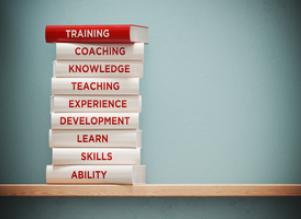10/13/2019
Making Professional Development Count
Professional development, or PD, is a fact of life for many teachers. Indeed, the National Education Association (NEA)—one of the nation’s largest teachers unions—contends that it “should be required throughout the career of education support professionals” and that teachers “should have a decisive voice at every stage of planning, implementation, and evaluation” along the way. However, not all PD is created equal, and many educators believe that teacher-led, student-centered PD is the most useful.
How to optimize PD
Of course, cultivating this type of PD is easier said than done. In 2018, blogger and high school teacher Larry Ferlazzo tackled the topic of “bad” PD in his “Classroom Q and A” column for Education Week. After posing the question “What are the biggest problems with common teacher professional development practices and how can they be fixed?”, Ferlazzo invited a small group of experienced educators to share their insights, concerns, and personal experiences.
For Diana Laufenberg, who has years of experience as a social studies teacher and education entrepreneur, the No. 1 problem with school-run PD is that it often does not directly match up with what teachers are being asked to do in the classroom. “A teacher's professional development experience needs to be in agreement with the overall approach to teaching and learning that defines the learning environment,” Laufenberg opined. She went on to argue that if a school is focused on a particular instructional method, such as project-based or personalized learning, then PD teachers should likewise focus on this methodology—or, as she phrased it, “When you believe something about learning, it needs to permeate all aspects of learning in the system, not just for the children.”
Ferlazzo’s post is full of teachers’ expert views on how to make PD purposeful and easily transferable to their classroom practice. Among the critiques of boring, abstract PD sessions, a number of passion-driven examples of engagement and downright joyousness jump out, many of which revolve around empowering teachers to design and lead their own PD. As noted by Dr. Melissa C. Gilbert, a math teacher and education researcher affiliated with Stanford University, “All educators have attended PD sessions presented by consultants who may never have been teachers themselves”—despite the fact that, in Gilbert's view, teachers are the experts in their own communities.

In a 2017 blog post for the independent research group Learning Policy Institute, Linda Darling Hammond, Marla E. Hyler, and Madelyn Gardner dove into defining “effective teacher professional development” and why it matters. Echoing some of the conclusions in Ferlazzo’s Education Week post, the trio pointed out that teaching is becoming an increasingly complex occupation that involves preparing students for a rapidly changing world.
“Sophisticated forms of teaching are needed to develop student competencies such as deep mastery of challenging content, critical thinking, complex problem solving, effective communication and collaboration, and self-direction,” they asserted. Thus, teachers need adequate time to learn, reflect upon, and practice the skills required to be successful.
After acknowledging that much of today’s PD is inadequate, Darling Hammond, Hyler, and Gardner turned their attention to when, how, and why some PD initiatives work so well. Using “methodologically rigorous studies” as a basis for their conclusions, they determined that good PD makes a positive impact on teachers and students, typically through active sessions that are immersive and mimic expected student experiences and outcomes.
Citing “an inquiry-based PD model designed to help high school biology teachers integrate literacy and biology instruction in their classrooms,” the researchers advocated for a “show” rather than “tell” model in which reflections, “think-alouds,” and text annotations are practiced by teachers. The trio noted that the resulting impact on student engagement and achievement was impressive:
In a randomized control study in a set of high-poverty schools, this active learning PD model resulted in student reading achievement gains equivalent to a year’s additional growth compared with control group students, as well as significantly higher achievement on state assessments in English language arts and biology.
An age-old concept
Though sometimes burdensome, PD is a natural extension of teachers’ impulse to keep learning and improving their practice. As pointed out by the PBS Online series “Only a Teacher,” which offers an intriguing look at how the teaching profession has evolved over the last 200 years or so, high expectations and frequently shifting priorities and pressures have always been part of the profession. Moreover, when teachers are encouraged to weigh in on their own PD opportunities, they're not the only ones who stand to benefit—students are likely to flourish, too.

